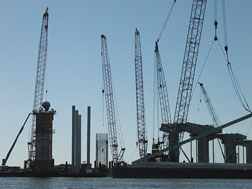 AP/Wideworld Column form collapse June 14 killed one worker on south side of U.S. Highway 90 bridge, under construction near Bay St. Louis, Miss. Rescuers continued to search for a second victim. Seven workers were recovered and treated at a nearby hospitals.
|
Recovery efforts will continue throughout the day at the U.S. Hwy. 90 Bridge over St. Louis Bay in Mississippi, where a column form collapsed shortly after 1 p.m. Thursday, June 14, tossing nine workers into the water.
Eight of the workers were recovered from the water in the immediate aftermath by the contractor and transported to Memorial Medical Hospital in Gulfport and Hancock Medical in Bay St. Louis, says Gary Hargrove, Harrison County Coroner. One of the workers died. “Alger Pennaman, 51 of Jackson was pronounced dead at 2:41 p.m. after resuscitation efforts were not successful,” Hargrove says. “An autopsy this morning showed that Mr. Pennaman died as a result of drowning.”
Not quite a month ago, the Mississippi Dept. of Transportation held a grand opening celebration May 17 when the joint venture contractors Granite Construction Inc. of Watsonville, Calif., and Atlanta-based Archer Western Contractors delivered the first two lanes of traffic on the $266.8-million bridge and received a $5-million bonus.
|
Rescue operations were suspended at dark yesterday when search and rescue divers couldn’t find the ninth victim. “This is a recovery instead of a rescue because there is nothing that would indicate that he could have survived from what happened,” says Chief Pat Sullivan, with the Gulfport Fire Dept., coordinating dive operations on site. “He was on the column. It went over and under water.”
Ladia Baloun, a tugboat operator for a subcontractor, saw the whole thing happen. “I was sitting there bringing the concrete in,” Baloun says. “The third bucket was in the air with the crane and this thing collapsed.”
By the time ambulances and emergency rescue workers arrived on the scene, workers had already pulled eight of the nine from the water. “The company that is building the bridge did an outstanding job of getting the people they could out of the water, getting the injured workers to dock, triage, medical and assisting us to getting out here immediately after the accident to attempt the rescue,” Sullivan says. “They had already removed the other people with company boats. Workers had jumped into the water to pull other people out.”
 Angelle Bergeron Ironworker scales rebar on north side Bay St. Louis bridge column form in undated file photo.
|
Divers are working closely with crane operators at the site, sifting through dangerous debris and working a pattern to recover the missing worker. “We rig the debris and everybody moves out of the way of the crane,” Sullivan says. “It is very methodical and makes for a slow operation, but we feel if there is not way to do a rescue, we don’t want to endanger anyone.”
A formal statement from MDOT indicates that the two traffic lanes are “open and safe for travel.” Indicating that “MDOT personnel were not involved in the incident,” the release refers all questions to the contractor, GAW. Calls to GAW on site and to Granite were not returned.
Hurricane Katrina destroyed the original bridge over St. Louis Bay August 29, 2005. GAW made history by delivering the first two lanes of the new bridge less than two years later. The contractor received the notice to proceed February 20, 2006, and didn’t actually begin pile driving until May 15, 2006. “No other bridge in the history of the U.S., the size and scope of this magnitude, has ever been done this fast,” said Larry L. “Butch” Brown, MDOT’s executive director.
“OSHA has an open investigation,” says Dan Fuqua, public affairs director for the Atlanta region of the Office of Safety and Health Administration. “They have six months to complete it.”
 Related Links:
Related Links: 
Post a comment to this article
Report Abusive Comment